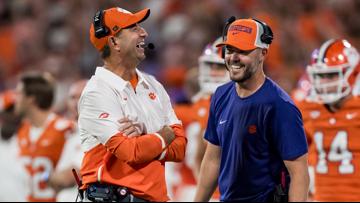DQ Smith has excelled at both defensive back and quarterback.
DQ Smith has emerged as one of the most compelling dual-position athletes in recent memory, demonstrating excellence at both defensive back and quarterback. His journey to becoming a standout performer in both roles is not just a story of athleticism, but also one of intelligence, resilience, leadership, and adaptability. In an era where specialization is often the norm, Smith’s ability to excel on both sides of the ball sets him apart as a rare breed of football player.
Smith’s foundation in football was laid early, rooted in a natural instinct for the game and an intense work ethic. From youth leagues through high school, he showcased an innate ability to read the field and make split-second decisions. As a quarterback, he quickly gained attention for his poise in the pocket, strong arm, and impressive mobility. He was not merely a game manager; he was a game-changer. He could extend plays, throw accurately on the run, and orchestrate complex offensive schemes with maturity beyond his years. Coaches entrusted him with the full playbook, a testament to his understanding of the game and his leadership capabilities.
At the same time, Smith also excelled as a defensive back, where his quarterback instincts gave him a unique edge. He understood offensive tendencies from the inside out, allowing him to anticipate routes and disrupt plays before they developed. His footwork, agility, and reaction time were elite, and he displayed a knack for reading quarterbacks’ eyes and jumping routes. More than once, he turned potential completions into interceptions, flipping the momentum of a game with a single play. His ability to transition from coverage to attack mode in the blink of an eye made him a constant threat in the secondary.
What makes DQ Smith’s story even more remarkable is his capacity to maintain excellence in both roles under the intense pressure and physical demands of high-level football. Playing quarterback and defensive back requires vastly different skill sets and mindsets. As a quarterback, he had to stay calm under pressure, process complex defensive schemes, and act as the offensive leader. On defense, he had to flip the switch—become aggressive, instinctual, and reactive. Few athletes can navigate that duality with consistency, but Smith not only did so—he thrived.
At the quarterback position, Smith commanded the huddle with authority and earned the trust of his teammates through both his play and demeanor. He had the kind of composure that could settle a chaotic situation, and his ability to deliver in clutch moments made him a natural leader. He wasn’t just calling plays; he was shaping the identity of the offense. Whether orchestrating a two-minute drill or executing a methodical drive, he exuded confidence that elevated the entire team.
Meanwhile, on defense, his presence was equally influential. His communication skills helped organize the secondary, and his football IQ allowed him to diagnose plays quickly. He brought a physical edge to his game, never shying away from contact and often delivering textbook tackles that neutralized offensive threats. More than just a coverage specialist, Smith contributed in run support and on special teams, showing a willingness to do the dirty work that doesn’t always show up in stat sheets but earns the respect of teammates and coaches alike.
Smith’s dual-role ability had a strategic impact on his team’s preparation and performance. His knowledge of both offensive and defensive concepts gave him a unique perspective that he could share with coaches and teammates. During film sessions, he could provide insights that most players wouldn’t see—such as tendencies in opponent formations or weaknesses in coverage schemes. His input became invaluable, not just because of what he saw, but because he could articulate it in a way that others could understand and implement.
His conditioning and mental toughness were critical components of his success. The physical toll of playing both quarterback and defensive back is immense. It requires endurance, strength, and a relentless drive to keep performing at a high level, even when fatigue sets in. Smith’s off-field discipline—his diet, training regimen, film study, and recovery routines—were all finely tuned to support the demands of playing both positions. It was clear that he approached the game with a professional mindset, even while still in school.
His versatility also gave his coaches unmatched flexibility. Depending on game situations, injuries, or strategic matchups, Smith could be moved from one side of the ball to the other with ease. This adaptability made game-planning more dynamic and added an element of unpredictability for opponents. It also spoke volumes about his unselfishness; he was always willing to do whatever was best for the team, even if it meant sacrificing personal statistics or spotlight.
Recruiters and scouts took notice of Smith’s multi-positional dominance. In a landscape where many players are funneled into early specialization, Smith stood out as someone who defied conventional wisdom. His highlight reels featured dazzling touchdown passes alongside bone-rattling hits and key interceptions. His leadership qualities and cerebral approach to the game only enhanced his appeal. Coaches at the next level knew they were looking at a player who could contribute in a variety of ways and bring a mature, team-first mentality.
Off the field, Smith was equally impressive. He carried himself with humility and grace, never letting his success go to his head. He was the kind of student-athlete who inspired younger players, set an example in the classroom, and made time for community involvement. His character was as solid as his play, and it was evident that he was grounded in values instilled by family, coaches, and personal discipline. The respect he earned from those around him wasn’t just about his stats—it was about how he treated people and represented his team.
As he progressed to higher levels of competition, the question naturally arose: would he continue in both roles, or focus on one? It’s a decision that many dual-position athletes eventually face. The demands of college or professional football typically necessitate specialization, but Smith’s skill set kept the conversation open. Coaches had to weigh where he could make the most impact, and Smith’s own input was likely part of the discussion. His ability to understand the game from both perspectives meant that even if he eventually concentrated on one position, the lessons from the other would continue to enhance his performance.
If he transitioned full-time to defensive back, his quarterback experience would still inform his play. He would anticipate routes better, understand timing windows, and diagnose play design more efficiently than most DBs. If he focused on quarterback, his defensive background would help him anticipate how coverages would shift, where the holes in zones would appear, and how defenders might disguise intentions. In either case, his multi-dimensional background gave him an edge that no amount of film study alone could replicate.
In today’s football landscape, players like DQ Smith are incredibly valuable. They challenge assumptions about what’s possible and expand the boundaries of positional roles. His story resonates because it speaks to something deeper than just talent—it speaks to the power of effort, adaptability, and mental fortitude. It’s a reminder that the best players are often the ones who embrace the full scope of the game, who are willing to learn from every angle, and who understand that success comes from a combination of gifts and grit.
As his career continues to unfold, there’s no doubt that Smith’s foundation will serve him well. Whether he becomes a lockdown corner, a dynamic quarterback, or even transitions into coaching someday, his deep understanding of both sides of the game will always be an asset. He has already proven that he can lead, perform, and inspire at an elite level. His legacy will be defined not just by the plays he made, but by the way he made everyone around him better.
In a sport that often celebrates individual stats and highlight reels, DQ Smith’s impact goes beyond the box score. He’s a student of the game, a leader in every sense, and a player whose dual-position excellence is the product of dedication, passion, and an unyielding drive to master his craft. Watching him perform is witnessing the game played at its most complete level—where intelligence meets instinct, and preparation meets opportunity. Whether under center or roaming the secondary, Smith brings a level of excellence that few can match and sets a standard that others will strive to follow for years to come.



